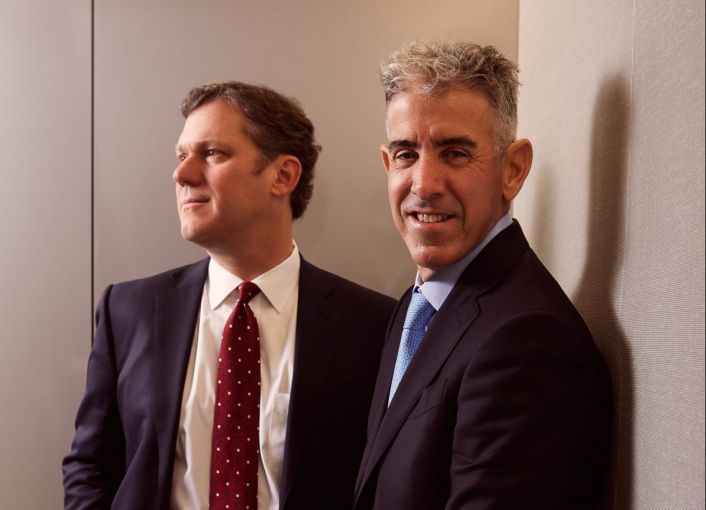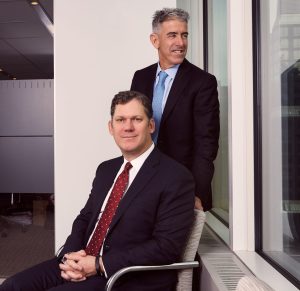California Dreaming: Mesa West Capital’s Journey From Costco Through the Crisis
By Mack Burke January 8, 2019 11:00 am
reprints
Recently, Mesa West Capital co-Founder and Principal Jeff Friedman was having a conversation with his daughter when she asked him, “Did the financial crisis hurt you?”
Friedman was caught off guard, realizing he had an unusual task of explaining how the second-largest economic crash in the history of the United States was a positive for his bridge debt fund, which was started in Los Angeles in 2004. Friedman, 56, and Mesa West co-Founder and Principal Mark Zytko, 52, began the firm by essentially creating mortgage pools for the pension fund world.
Fourteen years after launch, Mesa West was acquired by Morgan Stanley (MS) in March 2018, and that has vastly improved the breadth and scope of a credit platform that was eager to get on equal footing and expand its global footprint amid the growing horde of alternative lending shops. The duo has gone from furnishing its first offices in L.A. with Costco folding tables to a having over $5 billion in gross assets under management.
Surrounded by striking views of Midtown Manhattan, Friedman and Zytko sat down with Commercial Observer on the 23rd floor of Morgan Stanley’s 1585 Broadway outpost—far from their L.A. headquarters and stomping grounds—to chat about being under the banking giant’s umbrella, the conception and evolution of Mesa West and how it survived and thrived through real estate’s darkest days.
Commercial Observer: What led to Mesa West’s launch?
Jeff Friedman: We knew each other from working together at Credit Suisse First Boston, going back to 1998. I was in New York and Mark was in L.A. I was running an originations team in New York, but we spent a lot of time together. I left in 2000 to go work for developer Maguire & Partners, under Rob Maguire, and Mark left Credit Suisse in 2003. I was looking for the next thing to do. I had always wanted a finance company—there aren’t a lot of finance people in L.A.; everyone’s either in entertainment or they have a little manufacturing company or they own real estate. Finance is here in New York. If you ask your average L.A. person what private equity is, they know what private is but they don’t know what equity is.
Mark Zytko: When Jeff left, I stayed, but I began to notice a change in the business. When we first started at the bank, we could do anything. We wrote loans for the balance sheet; we wrote loans for securitization; we could write a first mortgage loan; we could write a mezzanine loan; we could even invest equity in a property. But as time went by, and the securitization market evolved, things became more and more inside the box. I had come from a history of working at a life insurance company, Sun American Investments, and I had worked at G.E. Capital. And even with the weaknesses of G.E. Capital, in having too many layers of decision making and thus being hard to deal with, the strength that they had was their flexibility; they could really do anything, but it got in its own way. When we were at Credit Suisse, we didn’t have that cumbersome decision-making process.
So you were hungry for freedom?
MZ: That was one aspect of it. We had made our business at Credit Suisse on providing a certain type of capital to good sponsors for transitional opportunities, really creating value for the equity. What we got in return was good real estate and a first mortgage position in the capital stack. As securitization took over, we couldn’t do that as well anymore. That was the driver for me. I was being constrained in the activities because of the bank’s desire to have it on the balance sheet for as little time as possible, fit it into the rating agency box and move it out in a securitization. [Jeff and I] thought there was an opportunity to better serve the needs of our clients by providing the flexible capital that would help them succeed in their business plans, give us good returns and put us in a nice, safe position in the capital stack. That’s the genesis [of Mesa West].
JF: We saw that banks and life insurance companies wanted mortgage exposure on their balance sheets—around 10 to 15 percent of their asset base. Pension funds, mostly public pension funds, couldn’t hire big origination teams to get this exposure themselves. Our thought, which was very new in 2004: Let’s raise capital from pension funds and give them exposure to mortgages. We’re like an outsourced investment arm for them. They were investing out of their equity buckets and we had to explain what debt was and how it worked. And now, fast forward—or slow forward—15 years later, it’s a mainstay for them.
MZ: I think the other interesting part is that many pension funds—and this was one of our big challenges starting out—didn’t really recognize that our product—low volatility, attractive cash flow and an overall attractive risk-adjusted return profile—was important for diversification. If you look at a bank or a life insurance company, the structure of the capital is actually very similar, especially with a life insurance company. They have very large pools of capital; their mandate is to be relatively safe, but the risk-adjusted return is a priority and the capital is pretty long dated. The structure of pension funds, where they have very lean staffs internally, made it so they hadn’t really been exposed to this product. But if you take it out of real estate context and look at the bigger picture, I would be shocked if you would see a major multibillion-dollar investor who only invested in the stock market and didn’t buy bonds. But that’s what they were doing within real estate. They were only buying the equity and they weren’t investing in the debt. It was a slow way forward and it took a long time for it to develop, but it’s found a place.
What was it was like setting up a debt shop as a new kid on the block in 2004?
JF: I’d say we owe our success to Costco. In the old days parents had what were called bridge tables, like the heavy tables that you have to lug around, the folding stuff—even the chairs were heavy. But Costco came up with these light plastic tables that you could easily move around. We started on these tables. As we grew you’d have to reorganize the workplace. It was almost like a WeWork for ourselves.
MZ: Flexible workspace! We didn’t know we were pioneering that, it’s just that we didn’t have any money.
JF: If they were like the card tables, the bridge tables, I’d have a broken back; I’d still be recovering from that. There were a lot of times of great joy in terms of starting the business, and then obviously a lot of times where it was like, “Oh my God. What did we do?”
MZ: It was really surprising because when we started, we had worked in institutions where the capital was there. At Credit Suisse, we were investing the bank’s capital. So, when we had to find the money—one of our biggest challenges—the people we went to didn’t view it the same way as the institutions where we had been. That was really an education process, ahead of the development of our company and the product.
JF: I think the thing I misjudged the most was I thought we were going to have this big bucket of capital. Like, everyone is going to come to us. We just have to open the door and they’re coming in. What we quickly realized was we’re in a service business, even though we have discretionary capital. Our goal and our DNA—where we fit in the market—is we want to be the first and last call. Our strategy met the bar of demand. With the investors, from a capital perspective, it met a need. And then the third thing is it seemed like it’d be fun to start a business.

What was it like navigating the rough waters of the crisis with a such a fresh product?
JF: Back then we were competing with [major] banks and investment managers—talk about market aggression. The players that eventually left the market were these huge providers of capital, originating $20 [billion] to $30 billion a year. They weren’t just large, but were the most aggressive. Lehman Brothers, Bear Stearns, Wachovia, Irish banks and some of the German banks were super aggressive; they just left the space. The supply of capital dipped, but more specifically, there was a much smaller supply of aggressive capital. That was the game changer that really expanded our opportunity.
MZ: Our investors would sort of scratch their heads at our product. Enough of them said, “yes,” that we were in business, but the product wasn’t fully accepted. Many real estate investors had losses in their real estate equity, in their stock portfolios and in other portfolios, but we continued to perform. In 2004, while some clients understood our platform, they hadn’t seen it in action. During the crisis, they got to see it in action when we protected principal and continued to pay out returns when they were marking down other portfolios. That’s another reason it was a benefit to us. It tested our model and proved itself out quite well. That helped us grow.
JF: The difference between then and now is there’s a lot less leverage in the system. The banks that are left are heavily regulated; they’re active but not aggressive. Their cost of capital is quite cheap, so they make nice returns without taking any sort of transitional risk. Their view is we’ll look at the project when it’s stabilized and has a nice bow around it, whereas we’ll take transition and part of our loan package will be to provide the bow that will be used—hopefully not to strangle us. Right now, most of our borrowers are private equity firms and private equity firms are not asking for the leverage, either.
Why is that?
JF: The ones that did use high leverage got roughed up back then and their investors were unhappy. And I think a lot of the private equity firms are thinking as much about their assets under management as they are about how much profit they can make on any given deal. They want to put in more equity so they can raise bigger and bigger funds to invest more capital, even though if they levered it up it’d be more accretive to their returns.
How did the Morgan Stanley acquisition come about?
JF: It’s pretty neat. We knew the Morgan Stanley real estate team going back 20 years. John Klopp, who runs global real assets at Morgan Stanley Investment Management, encompassing private and listed real estate and infrastructure, started and ran Capital Trust, a debt fund that ultimately became [Blackstone Mortgage Trust]. John knew our business and we knew him back from the olden days, if you will. But we had great comfort in the relationship. That made a world of difference. We were looking for a strategic partner. When we started the business, we were competing against a few similar firms. What’s happened over time is all these equity funds got into the space, so we saw multi-product platforms enter and we went from having a competitive advantage, or a comparable offering, to saying, “OK, we’re bringing less to the table than these other firms might be.” We went through a long process, meeting with a lot of groups, both U.S. and non-U.S. groups, but this felt like the best option to meet our strategic needs. We not only wanted to level the playing field but gain a significant strategic advantage globally.
The global footprint is a massive upgrade.
JF: [It] was very interesting. We had some exposure to foreign investors, but our view was if we were going to stay independent we’d have to set up offices overseas and build relationships. Partnering with Morgan Stanley allowed us to instantly tap into its massive global distribution network.
MZ: We could really plug right in, globally. Interestingly, [what we offer] is a product in the investment management world that Morgan Stanley didn’t have. They had real estate equity investing, infrastructure investment and REITs, but their clients were saying, “what about real estate debt?” It’s great to plug right in without any overlap.
What were the first steps after the acquisition?
JF: We spent the first six months getting settled and taking stock of what we had and looking at our customers’ needs to find good and durable opportunities. I would expect that we are going to have more credit products that will be within our core competencies and meet our existing customer needs. But, we’re not going to go out and change our stripes.
Where do you think we are in the current cycle and how do you best gauge trends in order to execute your strategy?
JF: It’s still challenging. We’re late-cycle. As a lender it’s not our job to predict what inning we’re in. An equity investor has to because they need the upside and the leasing volatility; they need the exit in order to make their math work. We have to predict that it’s the ninth inning, no matter what, and tomorrow it may change. It doesn’t make us as popular if we’re negative, but that’s our mindset, because if things work out really well and we’re only in the second inning, then we just get a loan paid back at par. I personally think that we’re late in the cycle and we could have a correction, but every day we walk into the office, we say, “Are there leaks on the boat? Do we know where our life jacket is so we can survive?”
MZ: It’s interesting because as the secured creditor, without the upside, we are supposed to think about how do we get the principal repaid. If the equity experiences downside, the bargain that goes with that is we should still get our money back. That’s the goal, but that doesn’t mean we can’t be constructive and do a lot of business, even in a late-cycle context, if you choose good properties, good sponsors and structure your loans well. While there were challenges in the financial crisis, it made it possible for us to outperform during a down cycle because we made good choices. We worked with our borrowers and we got through situations because before the cycle, we had set the table properly.
JF: Does the knife go on the left side or the right side?
MZ: Well, as long as it’s not falling, it can be on the left side or right side!


